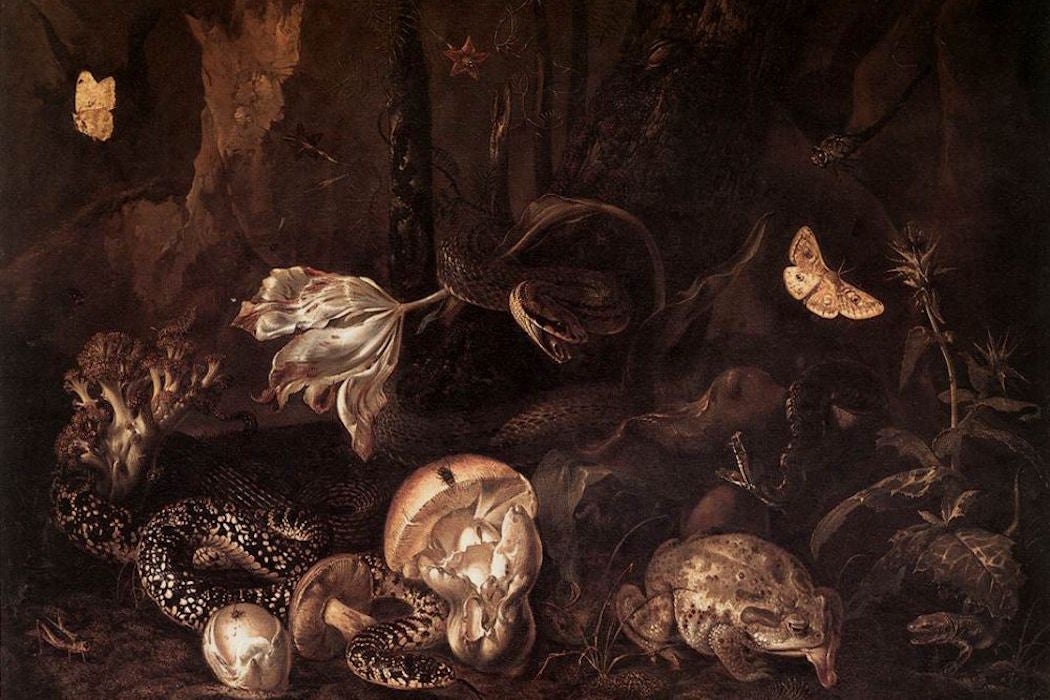In his book Mundus Subterraneus, the Jesuit polymath Athanasius Kircher shared his “recipe” for creating flies from scratch: “Collect a number of fly cadavers and crush them slightly. Put them on a brass plate and sprinkle the macerate with honey-water… you will see… otherwise invisible worms, which then become winged, perceptible little flies, and increase in size to animated full-fledged specimens.”
To readers at the time, a recipe for flies was not a particularly startling proposition. For many centuries, flies had been considered one of a class of animals that did not breed, but rather arose spontaneously out of inert materials. Creating them was simply a matter of engineering the right conditions. These “lower beings” included any manner of insects, along with snakes, scorpions, and frogs. Kircher’s book provided recipes for all of the above.
Get Our Newsletter
This theory of spontaneous generation would have seemed intuitive in a time before the advent of microscopes. One day, a leg of lamb or an old cheese is simply sitting there, rotting; the next, it is crawling with little white maggots. Perhaps, in its putrescence, the cheese gave birth to these little creatures! It seems likely enough!
Aristotle was the first to lay out a unified theory of spontaneous generation. In his view, there was a kind of vital heat, a life energy, that pervaded all matter. When this vital heat came into contact with air, earth, and water, it churned these elements into a kind of frothy bubble, a temporary life-form. They were ephemera, dispersing back into the flux of matter as quickly as they were formed.
Over time, categories of these beings were codified. Toads formed from mud heated by the sun, wasps from the rotting carcasses of horses, and bees from those of oxen. Ants formed from sour wine, and worms from soil. Household pests, like lice, bedbugs, and fleas, formed from human sweat. There were even tales of mice that formed from the earth so quickly that one might spot one congealing, its head and chest furry, its backside still a clod of dirt.
The mysterious ephemerality of spontaneously generated beings made them an object of fascination. During the Renaissance, they even inspired the development of a whole genre of painting, the sottobosco. Sottobosco means “undergrowth,” and that is precisely what these paintings focused on: the swampy world of mushrooms, frogs, snakes, and lizards. In these paintings, fauna and foliage merge. The darkness of the background blurs into the bodies of the animals, as if they are forming before your eyes, condensing out of the muddy shadows.
Around the same time, however, some scientists had begun to doubt the whole concept of spontaneous generation. One such thinker was Franceso Redi, an Italian naturalist. Redi had purchased Kircher’s book and, with diligent curiosity, set about trying his experiments. According to Kircher, a few pieces of decayed snake meat, placed on sun-warmed ground and exposed to rainwater, would, after a few day’s wait, spawn a profusion of miniature serpents. Yet no matter how many times Redi attempted “the generation of these blessed little hand-made snakes,” all he got was flies and more flies.
His disappointment fueled one of the most groundbreaking experiments in history. He placed hunks of meat in a series of jars, some open, some closed. Although the doctrine of spontaneous generation would dictate that all of the meats, as they rotted, would give rise to maggots, only the open containers sprouted the wriggling white worms.
Redi’s experiment won him lasting fame, but one of his contemporaries, Antonie van Leeuwenhoek, devoted his scientific career to disproving spontaneous generation. Leeuwenhoek was an unlikely scientific hero. He never had any formal education. In fact, he was a draper by trade, and he stumbled into the world of natural science quite by accident when he invented a new kind of microscope to get a better view at the threads in his cloth. Once he began to peer through his device, his attention quickly turned to the study of the miniature life he unearthed there: tiny insects and bacteria, which he termed “animalcules.”

Leeuwenhoek had a singular fascination with tiny creatures. When he studied lice, he kept them fed by housing them in one of his stockings, where they could feast on his foot, and he enlisted his wife to keep insect eggs warm in her bosom. By making these critters honorary members of his household, he was able to discover that they lay eggs, hatched, and pupated, rather than simply emerging from perspiration or dust. He was often spotted roaming the street of Delft with vials of fleas and larvae swaddled in his pockets. He loved to argue with the merchants in the local grain market. No matter what he said, they refused to believe that the weevils in their sacks of wheat did not simply materialize there.
Leeuwenhoek was awed by the beauty and complexity of the tiny creatures that he viewed magnified. The clockwork joints of a mite’s leg, the crystalline bulbs of a fly’s chambered eye, the delicate fur of a flea—he was able to see them, for the first time, in full, magnified magnificence. Leeuwenhoek saw that, contrary to the conventional wisdom, these “spontaneously generated” creatures were far from simple. In Leeuwenhoek’s eyes, lice and flies were as complex and well-formed as human beings, if not more so.
To modern eyes, the idea of spontaneous generation, life crystallizing from dirt, seems like magical thinking. And yet to Leeuwenhoek the revelation of the microcosm around him must have been equally magical. The idea that a mite could be as intricately constructed as a human being was an unthought-of wonder. Through his microscope, Leeuwenhoek saw rotifers paddle and bacteria bustle, a whole universe nestled within a water droplet. He perceived for the first time the fine-grained detail of the world through fresh, unjaded eyes. That’s a miracle much greater than a mouse curdling out of a clump of dirt.







